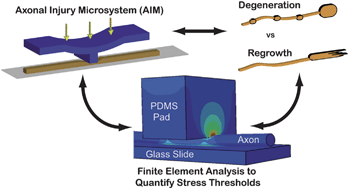We describe a novel valve-based microfluidic axon injury micro-compression (AIM) platform that enables focal and graded compression of micron-scale segments of single central nervous system (CNS) axons. The device utilizes independently controlled “push-down” injury pads that descend upon pressure application and contact underlying axonal processes. Regulated compressed gas is input into the AIM system and pressure levels are modulated to specify the level of injury. Finite element modeling (FEM) is used to quantitatively characterize device performance and parameterize the extent of axonal injury by estimating the forces applied between the injury pad and glass substrate. In doing so, injuries are normalized across experiments to overcome small variations in device geometry. The AIM platform permits, for the first time, observation of axon deformation prior to, during, and immediately after focal mechanical injury. Single axons acutely compressed (∼5 s) under varying compressive loads (0–250 kPa) were observed through phase time-lapse microscopy for up to 12 h post injury. Under mild injury conditions (< 55 kPa) ∼73% of axons continued to grow, while at moderate (55–95 kPa) levels of injury, the number of growing axons dramatically reduced to 8%. At severe levels of injury (> 95 kPa), virtually all axons were instantaneously transected and nearly half (∼46%) of these axons were able to regrow within the imaging period in the absence of exogenous stimulating factors.

You have access to this article
 Please wait while we load your content...
Something went wrong. Try again?
Please wait while we load your content...
Something went wrong. Try again?


 Please wait while we load your content...
Please wait while we load your content...